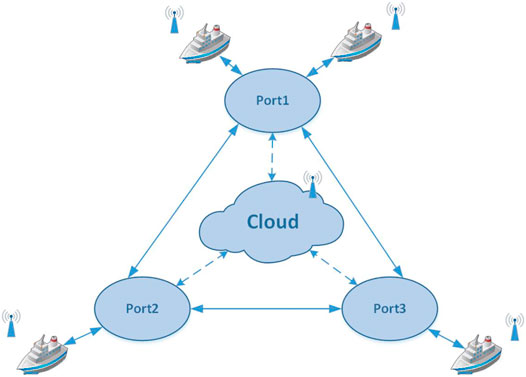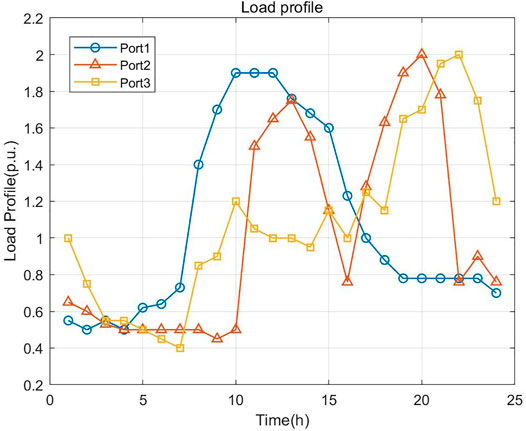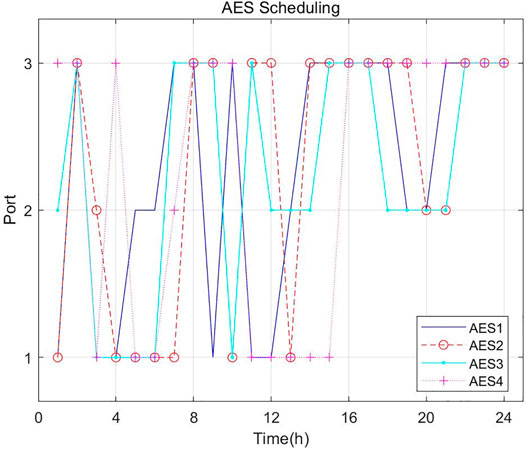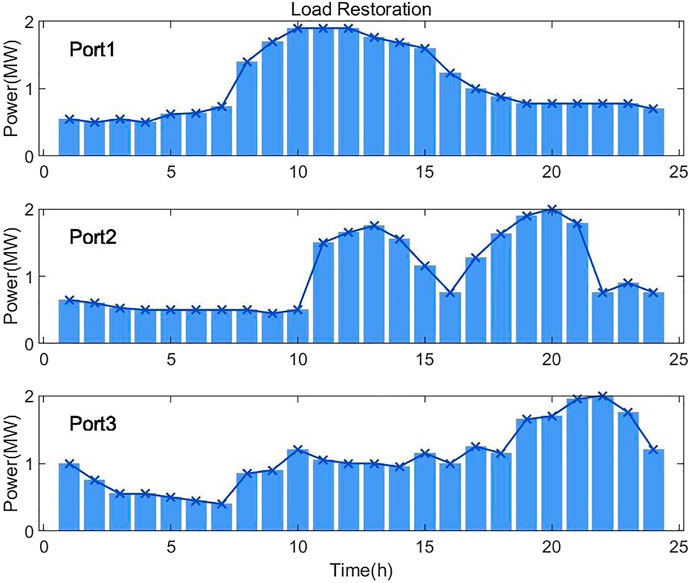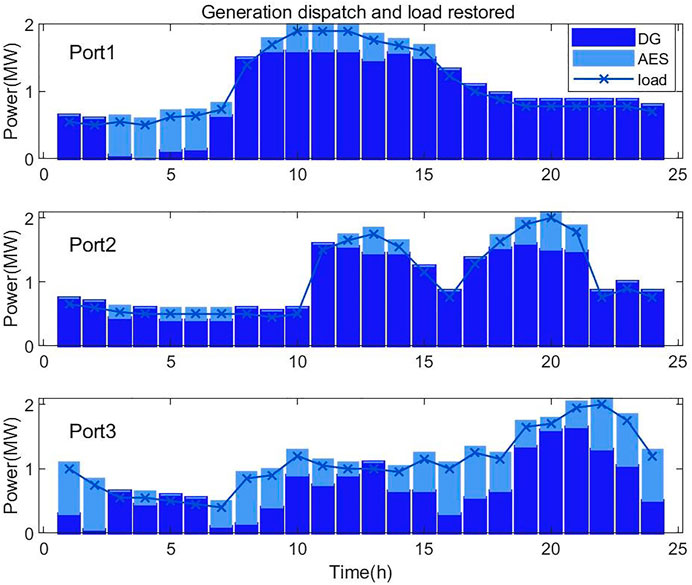- 1Maritime Big Data and Artificial Intelligent Application Centre, Navigation College, Dalian Maritime University, Dalian, China
- 2Marine Electrical Engineering College, Dalian Maritime University, Dalian, China
- 3College of Automation Engineering, University of Electronic Science and Technology, Chendu, China
In recent years, the rapid development of artificial intelligence, Big Data, Cloud Computing, etc., rapidly develops, synergy development of the transportation-energy-information based triple play has been accelerated. The all-electric ship (AES) is satisfied with the demand for both the unreasonable resource configuration of port energy system and low energy efficiency caused by sudden disasters. As a power carrier unit, AES has great potential in improving the resistance of port power distribution network for large-area blackout. Therefore, in this paper, a joint post-disaster restoration scheme for AESs and distribution generation scheduling in ports’ microgrid (MG) is proposed to minimize the cost of post-disaster restoration including customer interruption cost and AES operation cost. The time-space network (TSN) model which describes the scheduling of AESs is applied to compare the grid resilience and flexibility of AES-based joint dispatching and only relying on distributed generation equipment in post-disaster restoration. The joint scheduling problem is formulated as a mixed-integer linear programming. The proposed model and scheme are tested in a system with 3 ports and 4 AESs verified the resilience of the port power distribution network with AESs.
1 Introduction
With the acceleration of the global economic integration and the international economic activity becoming more and more frequent. Port as a national window opening to the outside world plays an increasingly important role. It is essential to promote coastal cities and has been regarded as the growth engine of a region or national economy (Li and Dong, 2014), especially in the regional economy of coastal cities. According to the data provided by the 2010 Shipping Statistical Yearbook, Shanghai port is the largest port in the world. In the same year, China accounted for six of the top ten ports in the world (Wang, 2011). Disasters of port could have far-reaching consequences for our country.
Meanwhile, China is one of the few countries which suffer serious loss from marine disasters (Wang, 2005). And the seaport is one of the hazard bearing bodies, in which large power facilities such as container handling machinery, transporting machine and service loads are damaged in different degrees, the electricity supply is interrupted, the application of intelligent diagnosis method in power transformers are still fall short (Yang et al., 2021) (Zhang et al., 2021). The post-disaster restoration is hindered which seriously threaten the lives of people’s and hard to reduce the economic loss. With increasingly abundant power equipment and high reliance of electricity, power system, as an important infrastructure related to security and economy, not only needs to meet the reliable operation in normal environment, but also maintains the requisites in the extreme condition (Ren et al., 2020). Emergency power supply system is essential.
Emergency power supply system is an independent generation device, which supplies electricity in case of unexpected power outage, increasing the resilience of microgrid, and protects life and property from the impact of power failure. Considerable progress has been made with respect to the utilization of stationary sources in distributed systems (DSs) restoration (Chanda and Srivastava, 2016) (Panteli et al., 2017). Distributed generators (DGs) are widely adopted in the restoration when the DS is isolated from the main grid (Wang and Wang, 2015). More scholars turn to the application of transportable energy storage system for post-disaster restoration.
As the green transportation, clean energy, artificial intelligence and Internet of Things technology (IoT Tech) rapidly develops, synergy development of the transportation-energy-information based triple play has been accelerated, and gives impetus to modernization of infrastructure. The more flexible mobile emergency power bringing new challenges and opportunities for power system recovery has been developed rapidly (Zhou et al., 2017). With the typical transportable energy storage system, e.g., electric vehicle, retention increasing dramatically year by year, V2G technology, self-driving and other relevant techniques having mature, the development tendency of the application of transportable energy storage system in electric power safeguard in the future has realized (Khodayar et al., 2013) (Chen et al., 2019). In 2000, Kempton and others first analyzed the feasibility of electric vehicles as distributed energy storage by coordinating the charging/discharging process of electric vehicles. For transmission networks, electric vehicles are applied to realize load shifting to improve the operation characteristics of grid (Lv, 2018). In recent years, the United States, Denmark, Japan and other developed countries and regions have vigorously promoted the relevant research. Hence, transportable sources, e.g., electric vehicles, have great potential to enhance the resilience through optimal scheduling among multiple islands within the DS.
AESs are regarded as transportable energy storage systems. Under the dual wheel drive of power security and environmental protection, AES with characteristics of clean, environmental protection and high energy efficiency continues to thrive in recent years, which is a kind of new energy ship with wide application prospects. In the port shore power stations, AESs are generally the user’s load. The rise of reverse charging technology promotes the transformation of AES from load to distributed power source, realizes the bi-directional interaction between ship grid and port grid. It leave the possibility for AESs to enhance the resilience of port’s microgrid.
In comparison to the fixed emergency power supply device, AESs’ flexibility is beyond doubt as a transport. AESs serve as a bridge for energy dispatching between ports, realizing flexible energy management as well as meeting the energy demand of post-disasters port’s microgrid which assist the post-disaster restoration. As a mobile power storage system, AESs play a strong role in power supply in the emergency of post-disasters.
AESs obviously have more advantages than electric vehicles in the specific environment of port grid. Against the electric vehicles with the identical flexibility, AESs have strong power storage capacity and diversified energy utilization. Namely, AESs’ single charging/discharging provide more power accommodation/energy supplement for the post-disaster port microgrid.
Except for the decided advantage in energy storage capacity, the AES is more powerful than electric vehicle in integrated utilization of multiple energy sources. Due to the limitation of cubage and other factors, the energy utilization types of electric vehicles are relatively single. However, the AESs utilize multi-kinds of energy simultaneously, e.g. solar resources, wind power, tide energy and other clean energy. What’s more, only can electric vehicles realize the energy dispatching among emergency power sources in the port, and cannot achieve the energy transportation management among ports. The AESs not only carry out dispatching inside the port by using the berthing position, but also dispatch energy among ports. The AESs highly accords with the demand of the post-disaster restoration of the ports’ microgrid, which is the excellent choice of the port uninterrupted power supply.
In recent years, the rapid development of artificial intelligence, big data, cloud computing and other related information technology has brought new strategies for energy interconnection and optimal operation which provides opportunities to the unreasonable resource allotment and low resource-efficient of port energy system caused by disasters. In this context, the AES-based joint energy dispatching comes into being. As a kind of carrier, AES building a bridge between the affected port and its neighbor grid realizes the electricity-centered energy interconnection of multiple ports. The AES-based joint scheduling build a foundation for the unified dispatching of multi-port grids and AESs’ energy storage system, maximize energy utilization, minimize the cost of post-disaster restoration. Meanwhile, adjustment of using energy from high-carbon to low-carbon is consilience of the current development theory and IMO energy conservation and environmental protection requirements (Fang et al., 2020).
In this paper, the research problems illustrate as follows: the connection of port grid and the main grid is fault after disasters, leading to a self-sufficient islanded microgrid of port. When a port is hit particularly hard, distributed generator are insufficient to meet the energy requirements, and thus AESs can be aggregated as a wide range of uninterruptible power sources for service restoration as far as possible. In this context, a joint post-disaster restoration scheme is proposed, in which AESs are dynamically scheduled in coordination with port restoration through microgrids, to minimize the total cost in the wake of disasters. Specifically, the islanded microgrid and AESs are described by using the temporal-spatial network model, and the mathematical model of AES operation is established to optimize the power dispatching scheme.
Main contributions are concluded as follows:
1) This paper proposes a joint post-disaster restoration scheme for berthing AESs and distribution generation in multi-port microgrid to minimize the cost of post-disaster restoration.
2) In order to evaluate the necessity and feasibility of AES-based joint scheduling, the mathematical model of restoration cost of the affected ports is established and resolve through MILP mean.
The remainder of the paper consists of four sections. Section 2 illustrates the system architecture in detail. Section 3 presents the modeling of AESs, ports and joint post-disaster restoration scheme. Section 4 provides the numerical results and analysis, and the paper is summarized in Section 5.
2 Joint Post-disaster Restoration Scheme
In the aftermath of the extreme events, ports’ microgrid has being place on island mode (Parise et al., 2016). AESs, as the power inter-connection bridge of adjacent ports, transfer the electricity to the post-disaster port. The total data, including AESs’ position and ports’ state, are aggregated to the cloud to work out the dispatching plan to provide guidance for AESs move as shown in Figure 1.
AESs join in the post-disaster restoration, increasing the resilience of microgrid of the port. For the sake of the best restoration scheme of port microgrid, the mathematical formulation of the joint post-disaster restoration scheme with the AESs is presented in this section, aiming at both minimizing the cost of joint post-disaster recovery and maximizing the efficiency of microgrid restoration. Furthermore, post-disaster recovery is characterized by the power recovery of local load. The customer interruption cost is adopted by distinguishing the load priority. The objective function and port operation constraints sets are described as follows.
2.1 Objective Function
The objective function considers two aspects: customer interruption cost and AES operation cost. AES part includes three aspects: AES transportation cost, DG generation cost and loss cost of shipborne battery, as follow (Yao et al., 2018):
The first term of the objective Eq. 1
In order to effectively dispatch the power resources, the travel of the AES is modeled by using the temporal-spatial network model (TSN model), which describes the vessels’ path in 24 h and the exchange of power with each port in detail.
3 The Model of AES-Based Dispatching
3.1 Temporal-Spatial Constraints of AES
In the TSN model, the transportation time of AESs among nodes is a time span. In practice, it makes hard to be consistent for each transit between ports (nodes). Therefore the virtual port (virtual node) is introduced, i.e. node 4 is introduced in between node 2 and node 3, so that the travel time of each arc between nodes (including virtual nodes) is exactly a time span, as shown in Figure 2 (Yao et al., 2018). The virtual node is similar to others except that it cannot be used as dock to transfer power. The TSN model can completely represent the whole process of AESs’ transportation and transmission.
The TSN-based AES model is formulated as follows:
Eq. 2 ensures that there is only one state for each AES at the same time, travel or berth, and the range is given. Eq. 3 ensures the flow of AES in each port that the entering and exiting number of AESs at any node is equal in sequential time. The constrain holds true for the virtual node. Particularly, constrain Eq. 4 is a special case of constrain Eq. 3 which express at the initial time. The constrain Eq. 5 place restrictions on AESs’ trace that AESs cannot course reversal immediately, which means it is necessary to via the intermediate port or berth a time space at the target port u. The constrain provides possibility for AESs to berth for power transmission and avoids unnecessary frequent round trip. The above-mentioned constrains do work for AESs in each time span.
According to the TSN model being in line with discrete time span in planning horizon of DGs, TSN model is suitable for scheduling in both representing the location of the AES and ensuring the AES mobile trajectory. Meanwhile, the AES and port microgrid operation are also oblige to guarantee.
3.2 Operation Constraints of AESs
When AESs berth at any port for power resource exchange, the following constraints should be met:
Eq. 6 shows the balance of supply and demand of AESs when berthing for power exchange.
Constraint Eqs. 7–12 represent the bound of the ship borne equipment to maintain their normal operation individually. Constraints Eqs. 7, 8 establish the feasible set of charging/discharging power of AES ω to port m.
With regard to AESs’ trajectory and operation constrains are expressed on above. The constraint set of port microgrid are described as next section.
3.3 Operation Constrains of Port Microgrid
The port is regarded as a complete microgrid from the grids’ perspective, which is a small power distribution system applied with equivalent distributed generation, energy storage system, local load and protection device connected by DC bus and controlled by grid control centre. While AESs are connected, the working constraints of microgrid are described as follows:
Eq. 14 stands for the co-ordination of supply and demand of the microgrid when AESs are connected and carry out charging/discharging operation.
Together with constrains of the AES-based joint post-disaster restoration scheme in Section IV, the dispatching problems pertain to a MILP problem, which can be solved by off-the-shelf business tools effectively, and the constraints are classified into the following 3 categories.
1) Temporal-spatial constraints of TESSs: Eqs. 2–5;
2) Operation constraints of AESs: Eq. Eqs. 6–13;
3) Operation constraints of port microgrid: Eqs. 14–18.
4 Numerical Results
In this section, the case studies are performed on the test system composed of three ports and four AESs to verify the validity of the proposed AES-based joint scheduling scheme. The optimization model is implemented using MATLAB 2020A, on a computer equipped with Intel Core i7 3.4 GHz CPU and 8 GB RAM.
All test problems are solved by intlinprog function in the commercial software MATLAB. “Intlinprog” is a mixed-integer linear programming solver, the abbreviation of mixed-integer linear programming (MILP).
4.1 Text System
In this study, the local load in adjoin ports at each time follows the load profile as given in Figure 3.
Owing to stressing on the difference functions, ports’ loads show discrepancy, which leading to load classification on supply side. Study assumes that the load classification of ports from low to high is port 1, port 2 and port 3, which is represented by load interruption cost in Table 1, 2.
Ports, shown in Figure 1, are regarded as the microgrid in the island mode, and the local load of each port follows the curve in Figure 3. For the sake of simplicity, four AESs with both identical properties and setting out to scheduling simultaneously are considered, which means that all the vessels have exactly the same attributes. The parameters of AESs are shown in Table 1. The time horizon is set to 24 h after disaster and time step is 1 h. The unit power generation cost of microgrid is $0.5/kWh. The unit transportation cost of AES is $80 per transit. The unit battery maintenance cost is set to $0.2/kWh.
In the remaining part, two cases are investigated to illustrate the feasibility of joint dispatching of AESs and DSs, as follows.
Case 1) A post-disaster restoration scheme only relies on distributed emergency generator.
Case 2) A joint post-disaster restoration scheme for AESs and generation scheduling in microgrids (MGs) is proposed.
4.2 Simulation Results
The comparison of the economic results under two cases is shown in Table 3.
Figure 4 provides the dynamics of AES in 24 h. Taking AES3 for instance to illustrate the schedule, it initially berths at port 2 and then through port 3 arrivals at port 1 (01:00–03:00), stays for 3 hours (03:00–06:00) to charge to port 1. Next, AES3 sails to port 3 (06:00–07:00) via port 2, supplies power to port 3 (07:00–09:00). Then departing from port 3 through port 1, port 3 and port 2 in turn (9:00–12:00). Finally moves to port 2 to transit energy to port 2 (12:00–14:00), and then moves to port 3 (14:00–15:00) for discharging 2 hours (15:00–17:00). After that, it returns to port 2 to discharge for 3 hours (18:00–21:00), moves to port 3 (21:00–22:00), starts to supply power from 22:00 to 24:00.
Figure 5 denotes the load recovery of joint post-disaster restoration scheme for AESs and generation scheduling in microgrids. The line diagram is identical as the load curve in Figure 3, indicating the change of local load. The variation of the median value of the column chart are perfectly in tune with restoring load. Figure 6 shows the stacked generation dispatch for microgrids and AESs. The lower part of the bar represents the equivalent active power generated by the distributed emergency equipment; the opposite depicts the feeding of power from AES to the port, which describes the load distribution explicitly. Therefore, it can be observed that the active power within each port is balanced along the optimization horizon while AES participate in restoration.
5 Conclusion
As a kind of carrier, AES has the potential to be a distributed emergency generation profit from its immensity power capacity, realizing by the two-way interaction between ship grid and port microgrid through shore power stations. Under the sensible scheduling, it has served as emergency power supply equipment for port microgrid restoration in the post-disaster condition. Therefore, a joint post-disaster restoration scheme for AESs and generation scheduling in microgrids (MGs) has been proposed to minimize the cost of port restoration. The TSN model has been applied to represent AESs in two dimensions: time and space. The port microgrid restoration cost has been established as a mixed-integer linear programming model, which has derived an AES scheduling sequence and generation dispatches for both AESs and resources in port. Taking three adjoining ports and four AESs as examples, the effectiveness of the scheme has been verified.
The comparative simulations have been implemented to illustrate the availabilities of AES on port microgrid restoration. The high-capacity and transportability of AES has guaranteed the feasibility to effectively transfer energy to microgrids, being adjunct to the local loads’ operation after disaster, and minimizing losses. The post-disaster island grid can be regarded as a microgrid operating in island mode while the cable disconnection of the inland main grid. Hence, this paper has a certain reference significance for the island post-disaster restoration.
Data Availability Statement
The original contributions presented in the study are included in the article/Supplementary Material, further inquiries can be directed to the corresponding author.
Author Contributions
WX and QS designed the experiments, research methods, and the format analysis. The tools analysis, data processing, and the original draft were carried out by WX. FT performed the writing-review on references. TL contributed to proof reading and project/organisation management. All authors have read and agreed to the published version of the article.
Funding
This work is supported in part by the National Natural Science Foundation of China (under Grant Nos. 51939001, 61803064, 61751202, 61903092, 61976033, U1813203); the Science and Technology Innovation Funds of Dalian (under Grant No. 2018J11CY022); the Liaoning Revitalization Talents Program (under Grant Nos. XLYC1908018, XLYC1807046); the Natural Science Foundation of Liaoning (2019-ZD-0151); the Fundamental Research Funds for the Central Universities (under Grant Nos. 3132019345, 3132020103, 3132020125, 3132021140).
Conflict of Interest
The authors declare that the research was conducted in the absence of any commercial or financial relationships that could be construed as a potential conflict of interest.
Publisher’s Note
All claims expressed in this article are solely those of the authors and do not necessarily represent those of their affiliated organizations, or those of the publisher, the editors and the reviewers. Any product that may be evaluated in this article, or claim that may be made by its manufacturer, is not guaranteed or endorsed by the publisher.
References
Chanda, S., and Srivastava, A. K. (2016). Defining and Enabling Resiliency of Electric Distribution Systems with Multiple Microgrids. IEEE Trans. Smart Grid 7, 2859–2868. doi:10.1109/tsg.2016.2561303
Chen, B., Ye, Z., Chen, C., and Wang, J. (2019). Toward a Milp Modeling Framework for Distribution System Restoration. IEEE Trans. Power Syst. 34, 1749–1760. doi:10.1109/tpwrs.2018.2885322
Fang, S., Xu, Y., Wang, H., Shang, C., and Feng, X. (2020). Robust Operation of Shipboard Microgrids with Multiple-Battery Energy Storage System under Navigation Uncertainties. IEEE Trans. Vehicular Technol. 69, 10531–10544. doi:10.1109/tvt.2020.3011117
Khodayar, M. E., Wu, L., and Li, Z. (2013). Electric Vehicle Mobility in Transmission-Constrained Hourly Power Generation Scheduling. IEEE Trans. Smart Grid 4, 779–788. doi:10.1109/tsg.2012.2230345
Li, H., and Dong, D. (2014). On the Development Status of china’s Port Industry and its Role in the Development of National Economy. Shandong Soc. Sci., 144–149. doi:10.14112/j.cnki.37-1053/c.2014.01.004
Lv, R. (2018). Research on Load Guarantee Strategy of Offshore Island Based on mobile Energy Storage Power Supply Network. Ph.D. thesis. Huazhong University of Science and Technology.
Panteli, M., Trakas, D. N., Mancarella, P., and Hatziargyriou, N. D. (2017). Power Systems Resilience Assessment: Hardening and Smart Operational Enhancement Strategies. Proc. IEEE 105, 1202–1213. doi:10.1109/jproc.2017.2691357
Parise, G., Parise, L., Martirano, L., Ben Chavdarian, P., Chun-Lien Su, C. L., and Ferrante, A. (2016). Wise Port and Business Energy Management: Port Facilities, Electrical Power Distribution. IEEE Trans. Ind. Applicat. 52, 18–24. doi:10.1109/tia.2015.2461176
Ren, J., Chen, J., Jiang, X., Sun, X., Zhang, S., and Li, W. (2020). Post-disaster Recovery Strategy of Resilient Distribution Network Considering mobile Energy Storage System and Network Reconfiguration. Electric Power Construction 41, 86–92. doi:10.3969/j.issn.1000-7229.2020.03.011
Wang, A. (2005). Marine Disaster Losses and Disaster Prevention and Mitigation Strategies in china in Recent Years. Jiangsu Geology. 029, 98–101.
Wang, J. (2011). Risk Analysis and Assessment of Typical Natural Disasters in Coastal Ports. Ph.D. thesis. East China Normal University.
Wang, Z., and Wang, J. (2015). Self-Healing Resilient Distribution Systems Based on Sectionalization into Microgrids. IEEE Trans. Power Syst. 30, 3139–3149. doi:10.1109/tpwrs.2015.2389753
Yang, D., Qin, J., Pang, Y., and Huang, T. (2021). A Novel Double-Stacked Autoencoder for Power Transformers Dga Signals with Imbalanced Data Structure. IEEE Trans. Ind. Electron., 1. doi:10.1109/TIE.2021.3059543
Yao, S., Peng, W., and Zhao, T. (2018). Transportable Energy Storage for More Resilient Distribution Systems with Multiple Microgrids. IEEE Trans. Smart Grid 10, 3331–3341. doi:10.1109/TSG.2018.2824820
Zhang, G., Chu, S., Jin, X., and Zhang, W. (2021). Composite Neural Learning Fault-Tolerant Control for Underactuated Vehicles with Event-Triggered Input. IEEE Trans. Cybern. 51, 2327–2338. doi:10.1109/TCYB.2020.3005800
Zhou, B., Xu, D., Li, C., Cao, Y., Chan, K. W., Xu, Y., et al. (2017). Multiobjective Generation Portfolio of Hybrid Energy Generating Station for Mobile Emergency Power Supplies. IEEE Trans. Smart Grid 9, 5786–5797. doi:10.1109/TSG.2017.2696982
Keywords: AES, port microgrid, post-disaster restoration, energy scheduling, transportable energy storage system
Citation: Xia W, Shan Q, Teng F and Li T (2021) Power Dispatching of Transportable Energy Storage System for Post-disaster Restoration Scheme of Port: The AES-Based Joint Restoration Scheme. Front. Energy Res. 9:730632. doi: 10.3389/fenrg.2021.730632
Received: 25 June 2021; Accepted: 23 August 2021;
Published: 07 September 2021.
Edited by:
Qiuye Sun, Northeastern University, ChinaReviewed by:
Yue Wu, Southwest Jiaotong University, ChinaChaoke Gong, Dalian University of Technology, China
Copyright © 2021 Xia, Shan, Teng and Li. This is an open-access article distributed under the terms of the Creative Commons Attribution License (CC BY). The use, distribution or reproduction in other forums is permitted, provided the original author(s) and the copyright owner(s) are credited and that the original publication in this journal is cited, in accordance with accepted academic practice. No use, distribution or reproduction is permitted which does not comply with these terms.
*Correspondence: Qihe Shan, c2hhbnFpaGVAMTYzLmNvbQ==
 Wenjia Xia
Wenjia Xia Qihe Shan
Qihe Shan Fei Teng
Fei Teng Tieshan Li1,3
Tieshan Li1,3